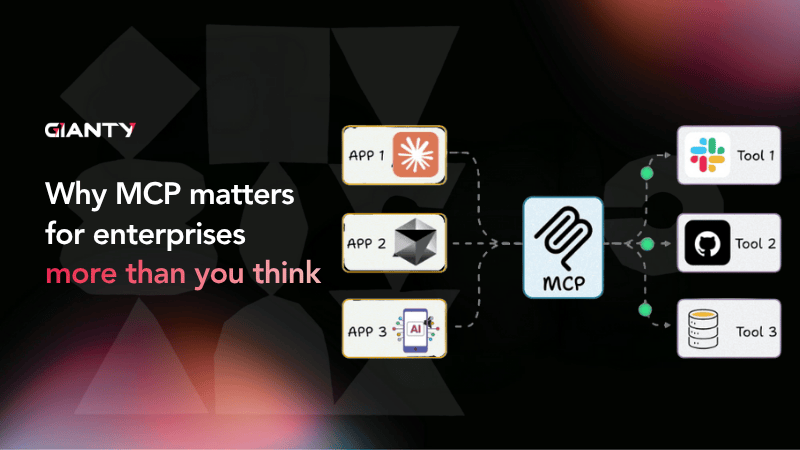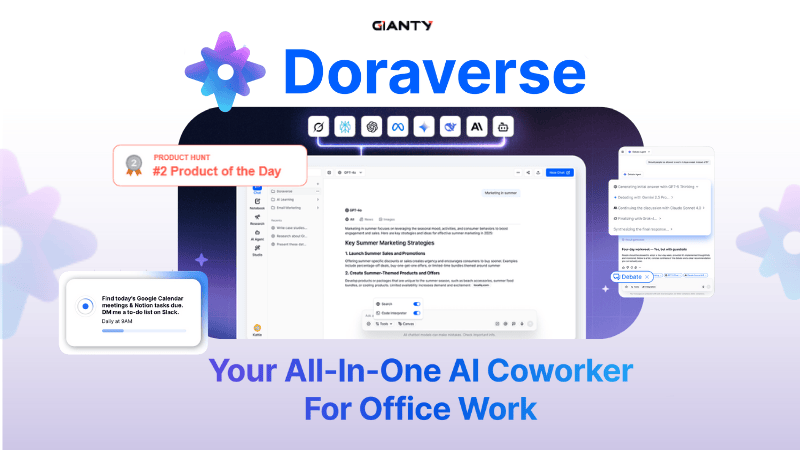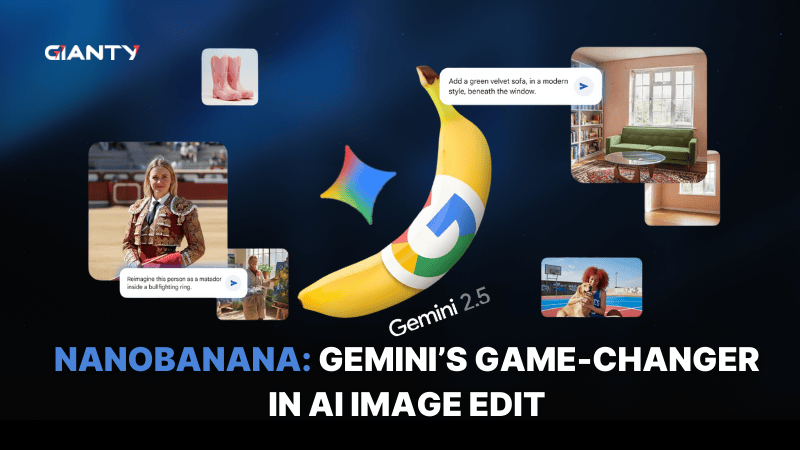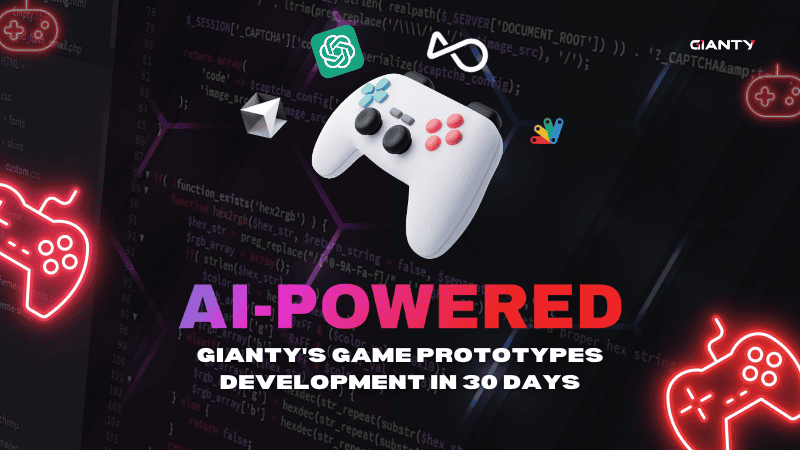In 2025, AI has shifted from a “nice-to-have” to a core operational layer inside modern businesses. Internal teams now depend on AI tools for workflow automation, assisting decision-making, accelerating content production, optimizing operations, and enabling employees to work faster with fewer steps.
But with AI becoming more capable and more complicated, businesses everywhere face the same strategic question:
Should we build our own AI tools, or buy existing ones?
This “Build vs. Buy AI Tools” decision is no longer just an IT consideration. It’s a business transformation choice that affects cost, speed, data security, and long-term competitiveness.
This article takes you through the strategic decision of Build vs. Buy AI Tools, and offers a refined decision matrix, including partnering with an AI Development company as a third option.
The 2025 AI Decision Challenge: Build vs. Buy AI Tools
According to McKinsey Global Survey 2025, 88% of organizations report regular AI use in at least one business function, up from 78% last year. Yet only around one-third of organisations report they have scaled AI beyond pilot phases.

The key insight: AI is available, but value capture remains elusive. For decision-makers, this means the strategic choice of how you adopt AI internal tools matters more than ever.
AI capabilities have evolved quickly. Companies are no longer experimenting with simple chatbots or text generators. They now deploy:
- AI assistants embedded in daily workflows
- Multi-step AI automations that replace manual processes
- AI agents that interact with internal systems
- Domain-specific copilots for teams and departments
- AI-based knowledge search for company documentation
- Predictive and analytical AI tools for operations
The challenge is generic. Consider two fundamental paths:
- Buying off-the-shelf AI tools: quick, lower upfront cost, but built for general use-cases and may lack deep workflow fit.
- Building custom AI internal tools: higher upfront investment, but tailored to your data, systems, and workflows, and with potential long-term advantage.
The answer depends on your operations, data sensitivity, engineering resources, and expected ROI. In addition, we’ll explore a hybrid, partnering approach that combines custom build with an external AI Development company.
What “Smarter” AI Internal Tools Mean for Businesses?
Like we mentioned above, AI internal tools are no longer simple utilities. They are becoming essential productivity infrastructure.
Smarter internal tools are defined by several characteristics:
- Deep understanding of internal data: AI internal tools must understand company documents, SOPs, databases, past decisions, and role-specific context. This requires secure internal data access.
- Workflow-level intelligence: Modern AI can perform multi-step tasks, follow conditions, trigger actions, update systems, and collaborate with employees—not just generate text.
- Role-based copilots: AI tools adapt to each role: operations manager, sales rep, warehouse team member, HR specialist, product owner, or customer success agent.
- Integration across business systems: To be effective, internal AI must interact with CRMs, ERPs, spreadsheets, ticketing systems, cloud storage, and databases.
- Operational reliability and compliance: Enterprises require auditability, controlled behavior, predictable outputs, and a clear boundary of what AI can or cannot do.
These features differentiate “internal AI tools” from generic AI Tools. The key challenge for decision-makers: Does your business need a generic tool speed or a workflow-specific internal capability?
Why Buying AI Tools Is No Longer Enough
The “buy” strategy was often the default when AI first became widely available: select a SaaS AI tool, spin up the team, and deploy quickly.

However, by 2025, many organisations will have discovered the limitations of this approach. Buying Off-the-Shelf AI tools is falling short because:
- Limited customization: Most AI tools are unable to adapt to unique internal workflows or business logic. Teams must change their workflows to fit the tool.
- Limited integration: Generic tools cannot deeply integrate with your internal databases or systems, reducing automation potential.
- Data privacy and compliance constraints: Sending sensitive operational data to third-party environments is risky for finance, healthcare, logistics, real estate, government, and enterprise customers.
- Growing long-term cost: Subscription-based AI tools scale poorly. As teams increase usage, costs rise significantly with each new user or workflow.
- Competitive parity: When every competitor buys the same AI tool, no one gains a unique productivity advantage.
Build vs. Buy AI Tools: Detailed Comparison
The following comparison outlines the key considerations for enterprise leaders in 2025.
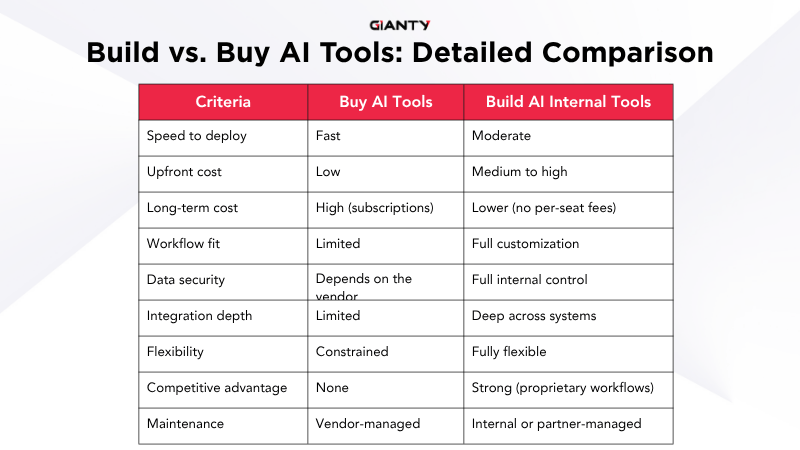
The table shows that buying is best for immediate needs, while building is best for long-term operational transformation.
What Is The Best Choice For Businesses: Build, Buy, or Partner?
In practice, many enterprises now choose a third option: partnering with an AI development company to build custom AI internal tools without hiring a full in-house AI team.
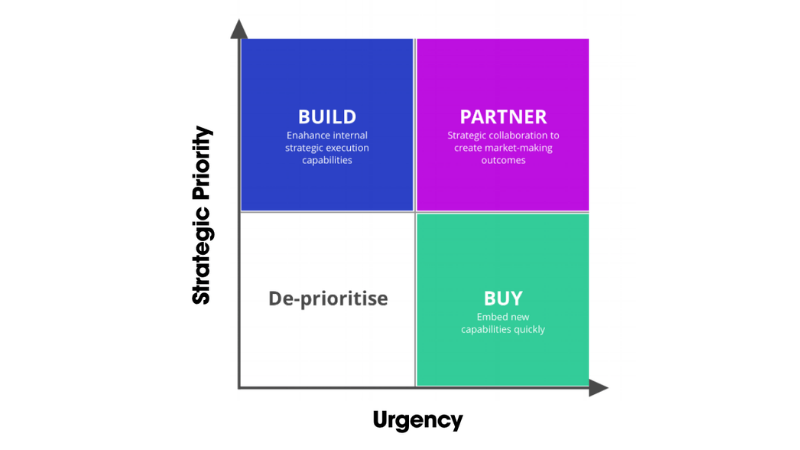
Key summaries:
Choose “BUY AI TOOLS” if:
- You need a solution immediately
- Your workflows are standard (e.g., generic chatbots, CRM insights)
- Cost is a pressing factor right now
- You don’t have engineering resources
- You’re early in your AI journey and just need a quick win
Buy = speed > uniqueness
Choose “BUILD AI TOOLS” if:
- Your workflows are unique or proprietary
- Data privacy is non-negotiable
- You want a long-term competitive advantage
- You need deep integrations with existing systems
- You’re already spending heavily on SaaS
- You want features SaaS tools don’t offer
Build = control + customization + long-term efficiency
Choose “PARTNER FOR CUSTOM AI DEVELOPMENT” if:
- You want custom tools, but don’t want to hire an AI team
- You need faster execution than internal dev can deliver
- You want expert guidance on architecture, workflow, and ROI
- You want predictable cost + scalable talent
Partner = Custom + Fast + Lower Risk (This is usually the sweet spot for companies exploring serious Internal AI Tools in 2025.)
GIANTY’s Point of View: AI Internal Tools Are Now a Productivity Engine
We’ve seen that businesses unlock the highest ROI from AI when:
- AI tools match internal workflows
- Data stays in the company’s own environment
- Automation reduces repetitive work across departments
- Teams get copilots that truly understand their SOPs
- Leaders gain visibility and measurable productivity outcomes
Instead of adopting dozens of SaaS tools, companies are now building the one AI system that fits their business: custom, integrated, role-aware, and secure.

One of GIANTY’s latest internal AI innovations is the AI Pixel Tool, an AI-assisted art workflow tool designed specifically for our game development teams. This tool streamlines early-stage visual prototyping by generating consistent pixel-style mockups based on design intent, gameplay context, and asset requirements. Instead of waiting for a full art pass during the prototype phase, developers can now create reliable placeholder visuals in the fastest time. See how it works here.
Beyond individual tools, GIANTY has also developed Doraverse, an all-in-one AI coworker platform designed to centralize and streamline every team’s workflows.
Together with tools like the AI Pixel Tool, Doraverse demonstrates how GIANTY’s approach to custom AI internal development helps businesses move from scattered AI usage to a fully integrated, high-productivity AI operating model.
GIANTY is an Asia-based AI Development Company specializing in building custom internal AI tools that improve productivity across entire organizations. With Japan-quality and scalable delivery teams in Vietnam, we help companies move from pilot phases to full deployment – built specifically for your internal use, not generic use.
Why 2025 Is the Best Time to Build AI Internal Tools
AI is no longer an expensive, complicated R&D. It’s now a practical business investment like building a dashboard or internal portal.
If you’re evaluating your Build vs. Buy AI Tools decision for 2025, here are some real questions decision-makers should ask before choosing:
- What tasks in our business require custom logic?
If >30%, building starts to make more sense.
- Do we need to control sensitive or proprietary data?
If yes, buying becomes riskier.
- Is speed more important this quarter? Or strategic advantage this year?
Your AI roadmap determines your path.
- Will we need deep integration with internal systems?
If yes → build.
- Are AI Tools subscriptions already stacking up?
Internal tools often reduce long-term costs.
And the best choice between Build vs. Buy AI Tools or Partner? There is no one-size-fits-all answer. But there is a smart answer. If you’re aiming for long-term efficiency, control, and competitive advantage, 2025 is the year internal AI tools move from “nice to have” to “core operations infrastructure.”
Still feel hard to decide? Reach out to GIANTY and share with us your AI vision.



